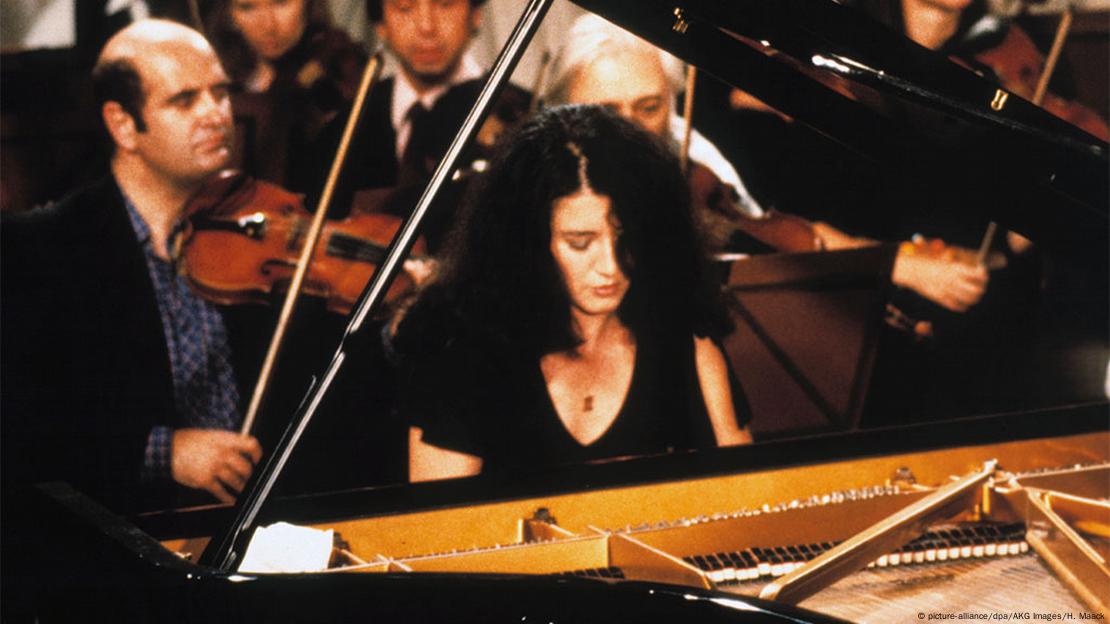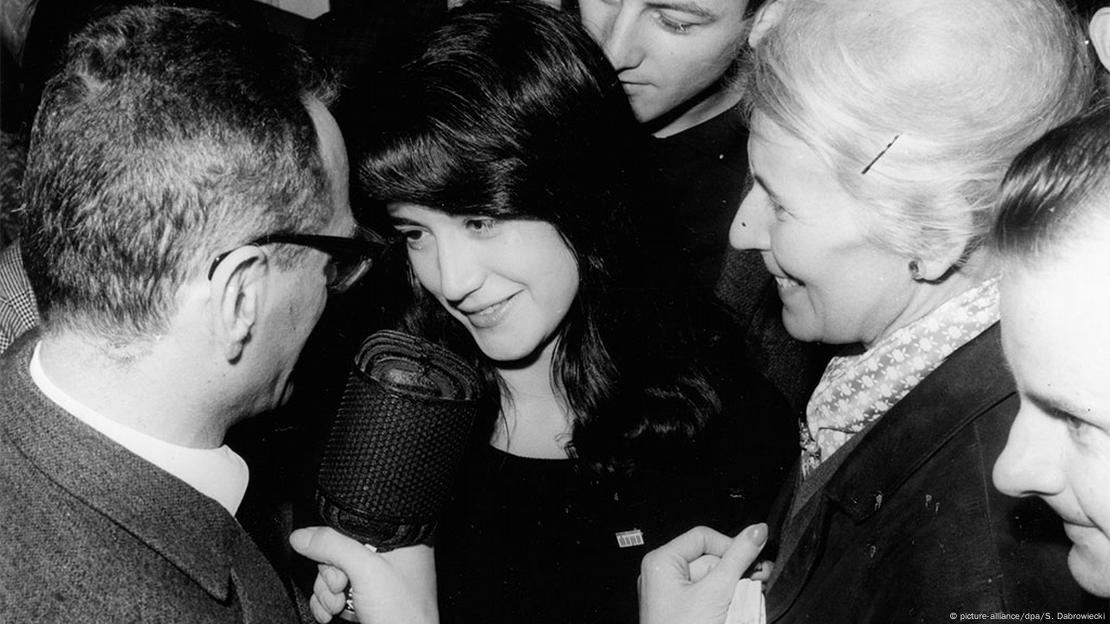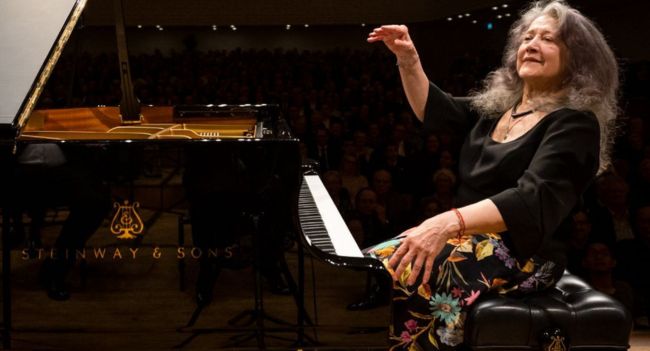At the age of 82, Martha Argerich remains an incomparable virtuoso, a performer marked by special charisma and nuanced, agile technique.
She is also regarded as a moody and unpredictable diva. Over the years, her energetic performances and her signature long mane — once dark, now graying — earned her the nickname “lioness” of the piano.

From Buenos Aires to Europe
Argerich was born on June 5, 1941, in Buenos Aires. Her maternal grandparents were Jews who had fled to Argentina to escape the antisemitic pogroms of tsarist Russia in the early 20th century.
She began playing the piano at the age of three. To her mother, Juanita, it was immediately clear that the child was a genius. Argerich was seven when she gave her first public concert. From that moment on, the life of the family started revolving around the career of the incredibly talented daughter.
In 1954, when Argerich was 13, her mother managed to speak to Argentine dictator Juan Peron. Shortly after, she and her husband secured positions at the Argentine Embassy in Austria, giving the family diplomatic status and allowing Martha to study in Vienna.
Argerich soon began studying with renowned pianist Friedrich Gulda, who found his best student “neurotic, weak-willed, spoiled,” criticized her dissolute lifestyle and doubted the young woman’s potential future career.
Argerich never got up before noon, became a chain smoker and gave birth to her first child at the age of 20; nevertheless, her talent was undeniable and she won one competition after another.
In 1957, she received first prize at the renowned Ferruccio Busoni International Piano Competition in Bolzano, Italy, and in 1965 she won the legendary International Chopin Piano Competition in Warsaw, Poland. As in her debut as a 7-year-old, Argerich played Beethoven’s Piano Concerto No. 1. The audience went wild, jury members wiped tears from their faces, journalists lined up for interviews. She had become a star before she had even turned 25.

Daniel Barenboim, the Argentine-born conductor, pianist and childhood friend of Argerich, described the virtuoso’s special talent in The Washington Post: “From the beginning, she wasn’t … only concerned with dexterity and speed. She mastered those as well, of course, but her fantasy enabled her to create a very unique quantity and quality of sounds on the piano.”
Canceling at short notice
In the following five and a half decades of her career, Argerich experienced many private setbacks but hardly any professional ones. She played brilliantly and with devotion as she honed her incomparable style.
She also seemed to have a special connection to the composers whose works she regularly performed: Frederic Chopin, Robert Schumann, Franz Liszt, Maurice Ravel, Claude Debussy, Sergei Prokofiev, Igor Stravinsky, Peter Tchaikovsky and, of course, Wolfgang Amadeus Mozart and Ludwig van Beethoven. She has been known to say such things as, “Schumann likes me,” or “Prokofiev never lets me down.”
However, Argerich became infamous for canceling performances at short notice. The first time took place when she was 17. She cited a finger injury as the reason and deliberately cut her finger to legitimate the story. Later, to avoid canceling, she simply would not sign a performance contract until the evening of the concert. Promoters and audiences accepted such conditions in order to experience “La Martha” live onstage.
Fleeting loves, lifelong friendships
As much has been written about Argerich’s private life as her musical career. She gave birth to three daughters by three men — all musicians. In addition, she had numerous relationships throughout her life, especially with famous conductors and fellow pianists — though her love interests apparently also included violinists and cellists.
In a 2011 biography of Argerich, French journalist Olivier Bellamy — one of few with intimate knowledge of the pianist — attested to her “chaotic lifestyle” but also to her warm, almost motherly way of dealing with people. This rare talent provided Argerich with close lifelong friendships, such as with Barenboim.
The support of friends helped Argerich get through tough times, including a cancer diagnosis in the 1990s. Pianist Stephen Kovacevich, to whom Argerich was briefly married in the 1970s, broke off his world tour and rushed to Los Angeles, where Argerich underwent surgery. The next day, Barenboim and another childhood friend, conductor Zubin Mehta, were also standing in Argerich’s hospital room with a bouquet of red roses.

Another declaration of love is the 2012 documentary film Argerich — Bloody Daughter, in which Stephanie Argerich, the youngest of the pianist’s three daughters, paints a tender, humorous portrait of her legendary mother.
Argerich, who lives in Geneva, Switzerland, is celebrating her 80th birthday with her friends, children and grandchildren. Shortly thereafter she will be off to Hamburg, where she will be hosting her own festival at the end of June.
The opening event will feature Argerich performing with Barenboim; however, some of the 12 concerts may have to be rescheduled due to the pandemic.
Nevertheless, she has no plans to stop making music: According to Argerich herself, music is something that she can do rather better than everyone else.
Accompanied by the Verbier Festival Orchestra, the great Argentine pianist Martha Argerich performs Pyotr Ilyich Tchaikovsky’s Piano Concerto No. 1 in B-flat minor, Op. 23. Conductor: Charles Dutoit. Recorded at the Verbier Festival in 2014. Encore: Robert Schumann: “Scenes from Childhood,” Op. 15, No. 1.
Tchaikovsky’s Piano Concerto No. 1
Pyotr Ilyich Tchaikovsky’s Piano Concerto No. 1 in B-flat minor, Op. 23, is one of the composer’s most famous works and is considered one of the greatest piano concertos ever written.
Movements
The concerto follows the traditional form of three movements:
- Allegro non troppo e molto maestoso – Allegro con spirito (B flat minor – B flat major).
The first movement begins with a grand opening statement from the orchestra, featuring a dramatic melody played by the horns and trumpets. The solo piano then enters with a series of rapid arpeggios that lead into the main theme of the movement, which is a powerful, driving melody played by the piano. The main theme is then repeated several times with variations, showcasing the virtuosic capabilities of the pianist. The orchestra also plays a prominent role in the movement, providing a rich and colorful backdrop for the soloist’s performance. The middle section of the movement features a beautiful and lyrical second theme, played by the strings and woodwinds. The piano then takes over the melody, performing it with great sensitivity and expression. The movement then builds to a thrilling climax, with the piano and orchestra playing together in a frenzied and explosive cadenza. The movement concludes with a triumphant restatement of the main theme. Overall, the first movement of Tchaikovsky’s Piano Concerto No. 1 is a powerful and dramatic work that showcases the virtuosity and expressiveness of the solo pianist. It is a beloved and iconic piece of classical music that has captivated audiences for generations.
- Andantino semplice – Allegro vivace assai/Prestissimo (D flat major).
The second movement of Tchaikovsky’s Piano Concerto No. 1 in B-flat minor, Op. 23, is a beautiful and lyrical piece that provides a stark contrast to the dramatic and virtuosic first movement. The second movement is written in the key of D-flat major and is marked Andantino semplice, which means “slow and simple.” The movement begins with a serene and delicate melody played by the solo piano, accompanied by the strings. The melody is graceful and lyrical, and it sets the mood for the rest of the movement. The orchestra then takes over the melody, playing it with a lush and romantic sound. The piano then performs a series of variations on the main theme, showcasing the instrument’s expressive capabilities. The variations are gentle and introspective, and they provide a beautiful contrast to the virtuosic pyrotechnics of the first movement. The middle section of the movement features a beautiful and melancholic theme played by the oboe and clarinet, which is then taken up by the piano. The theme is full of emotion and expressiveness, and it serves as a poignant reminder of the beauty and fragility of life. The movement concludes with a gentle restatement of the main theme, performed by the solo piano and accompanied by the orchestra. The theme fades away into a quiet and peaceful coda, bringing the movement to a gentle and serene close.
- Allegro con fuoco (B flat minor – B flat major).
The finale of Tchaikovsky’s Piano Concerto No. 1 in B-flat minor, Op. 23, is a thrilling and energetic finale to the concerto. The movement is marked Allegro con fuoco, which means “fast and with fire.” The movement begins with a blazing and virtuosic passage for the solo piano, accompanied by the full orchestra. The piano then launches into the main theme of the movement, a fiery and energetic melody that is full of passion and excitement. The orchestra provides a rich and colorful backdrop for the piano’s virtuosic performance, with the brass and percussion adding a powerful and dramatic sound to the music. The piano then performs a series of variations on the main theme, showcasing the instrument’s technical capabilities and the soloist’s virtuosity. The middle section of the movement features a beautiful and lyrical melody played by the strings, which is then taken up by the piano. The melody is full of emotion and expressiveness, providing a brief respite from the excitement of the main theme. The movement then builds to a thrilling climax, with the piano and orchestra playing together in a frenzied and explosive cadenza. The cadenza is full of virtuosic flourishes and technical fireworks, demonstrating the full range of the soloist’s capabilities. The movement concludes with a triumphant restatement of the main theme, played by the piano and accompanied by the orchestra. The theme is full of energy and passion, bringing the concerto to a thrilling and exhilarating close.
